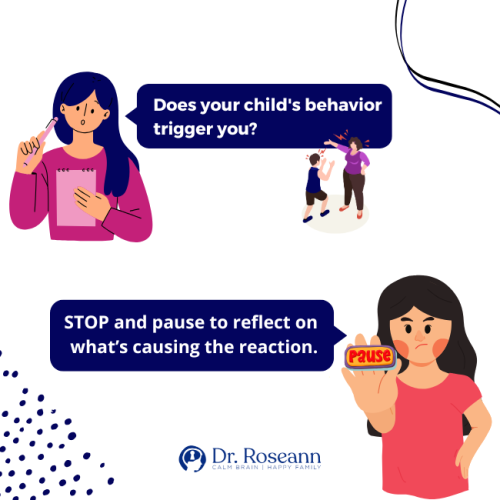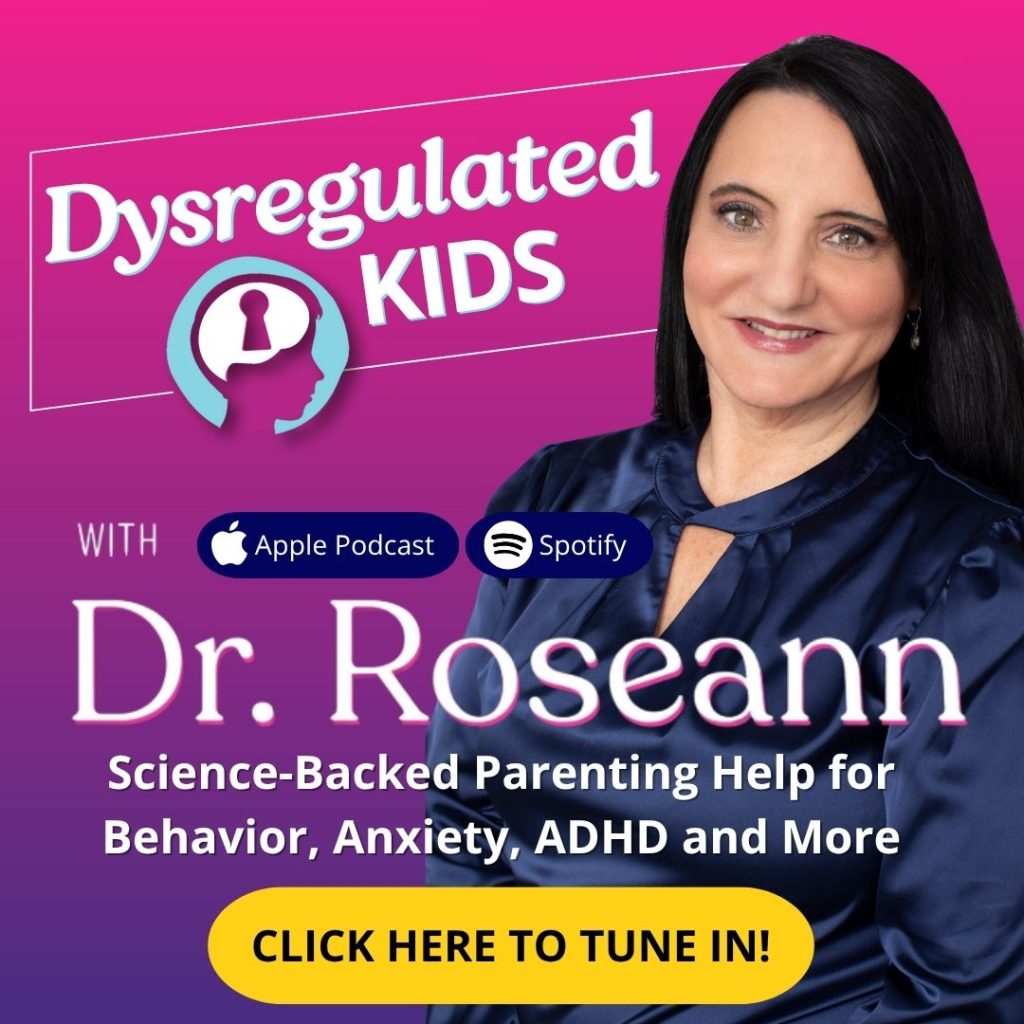Estimated reading time: 6 minutes
Every parent reaches that breaking point of frustration and exhaustion. You can’t calm a dysregulated child when your own brain is on fire.
This guide shows you how to be a calm parent—by regulating your emotions, understanding your nervous system, and using science-backed techniques that truly work.
Why Does Learning How to Be a Calm Parent Matter?
When your child explodes, your body often reacts too. Your nervous system shifts into fight, flight, or freeze—the same stress state your child is in. And when both of you are dysregulated, connection and teaching become nearly impossible.
That’s why, in my Regulation First Parenting™ framework, we always begin with:
- Regulate – Calm the brain first—for both you and your child.
- Connect – Build safety and trust before addressing behavior.
- Correct – Teach skills and guide behavior once regulation is restored.
Because when the brain feels safe and calm, everything else—behavior, focus, and cooperation—naturally follows.
What Causes Parents to Lose Patience?
Stress hormones, exhaustion, and guilt combine to form the “perfect storm.” Add a dysregulated child, and your own survival brain (the amygdala) goes into overdrive—parental stress and reduced well-being are well documented (Rusu et al., 2025).
Common triggers include:
- Lack of sleep or personal downtime
- Constant meltdowns or defiance
- Feeling judged by others
- Unresolved stress from work or relationships
Takeaway:
You’re not failing. Your nervous system is overloaded. Learning how to regulate your emotions as a parent helps you stay in control even when your child isn’t.
How Do Calm Parents Respond Differently?
Calm parents recognize their own triggers and choose regulation over reaction. They don’t ignore emotions. They model how to manage them.
Research shows that when parents stay regulated, children learn to do the same and show fewer behavioral struggles (Morris et al., 2017).
Calm parenting techniques include:
- Speaking softly when tension rises
- Using consistent routines for safety
- Offering limited choices to build control
- Focusing on connection before correction
Parent Story:
Samantha, a mom of a 9-year-old with anxiety, noticed her son shut down whenever she yelled. By whispering instead of shouting, she diffused power struggles and saw cooperation rise.
Takeaway:
Calm doesn’t mean permissive—it means present and regulated.
How Can You Regulate Your Emotions During Your Child’s Meltdown?

Your calm is the anchor your child’s nervous system needs. When your child melts down, start with your own regulation first.
Research shows that parental calm directly shapes a child’s stress response and emotional recovery (Rutherford et al., 2015).
Try this:
Pause | Step back and breathe before you speak. |
Ground | Feel your feet, unclench your jaw, and slow your breath. |
Connect | Approach your child with empathy—‘You’re having a hard time, not giving me a hard time. |
How Can You Be a Calmer Parent When You’re Burned Out?
Parent burnout is real—and it hijacks your ability to co-regulate. You can’t pour from an empty cup.
You can start small:
- Add five-minute self-care breaks
- Move your body daily—walk, stretch, breathe
- Prioritize sleep and magnesium-rich foods
- Use CALM PEMF™ or mindfulness to gently reset your nervous system
How Does Calm Rewire Your Child’s Brain?
Your calm literally reshapes your child’s neural pathways.
- Through mirror neurons, kids absorb your emotional tone long before they copy your words.
- Research shows that children’s brains reflect their parents’ emotional states through neural mirroring and co-regulation processes (Atzil et al., 2017).
Over time, your calm becomes their calm. That’s the foundation of Regulation First Parenting™—because no real learning or cooperation can happen until the nervous system feels safe.
What is the Science Behind Calm Parenting?
Calm parenting works because it helps balance the autonomic nervous system (ANS)—the body’s stress-control center. When the ANS is regulated, the brain’s higher functions can do their job, supporting:
- focus
- learning
- empathy
Research shows that parental stress and regulation strongly influence a child’s mental health and emotional stability (Păsărelu et al., 2022).
What are 21 Ways to Be a Calm Parent?
Below are 21 simple, science-backed calm parenting techniques that strengthen your emotional regulation and transform family life. Keep this list handy — it’s your blueprint for calm.
- Breathe before you speak. One slow inhale can stop stress before it spreads.
- Lower your voice. A calm tone signals safety to your child’s or teen’s nervous system (Waters et al., 2020).
- Label emotions aloud. “I’m frustrated right now” teaches kids that feelings can be managed (Eisenberg et al., 2010).
- Create predictable routines. Consistency helps everyone feel secure.
- Use visual schedules. Pictures ease chaos and strengthen focus (Crandall et al., 2015).
- Take short breaks. Two minutes of quiet can reset your patience.
- Designate a calm corner. A cozy spot for breathing, not punishment.
- Add movement. Walk, dance, stretch—let stress move through your body.
- Offer two choices. “Brush before or after pajamas?” keeps power struggles small.
- Use natural consequences. Let experience teach—without shame.
- Replace time-outs with regulation breaks. Calm first, correct later.
- Name your child’s feeling. “You’re sad because it didn’t go your way.”
- End the day with gratitude. Small reflections build resilience (Fredrickson, 2013).
- Problem-solve together. Mistakes are just lessons in disguise.
- Model apology and repair. “I yelled. I’m sorry.” Repair builds trust (Horn et al., 2019).
- Keep expectations realistic. Some days, small wins count big.
- Limit multitasking. Your presence matters more than perfection.
- Protect your sleep. Fatigue drains patience and clarity (Palmer & Alfano, 2017).
- Practice mindfulness or prayer. Stillness restores emotional balance (Laurent & Ablow, 2013).
- Laugh daily. Humor heals and reconnects hearts (Horn et al., 2019).
- Repeat your mantra: Regulate. Connect. Correct.™ Let calm lead the way.
When patience slips, remind yourself—it’s not bad parenting, it’s a dysregulated brain.
Calm the Brain First, Everything Follows.
Parent Action Steps
FAQs
How can I stay calm when my child keeps pushing boundaries?
Take a deep breath, name the feeling (“I’m frustrated”), and remind yourself this is a dysregulated moment—not defiance. Calm the brain first.
What if my partner isn’t calm?
Model the calm you want to see. Share short practices together like deep breathing or nightly check-ins.
Are there natural ways to calm my nervous system?
Yes—sleep, magnesium-rich foods, mindfulness, and gentle exercise all help restore nervous system balance.
Can calm parenting help ADHD and anxiety?
Absolutely. These conditions reflect nervous system dysregulation. Calming the brain improves focus, emotional control, and resilience.
What if I keep failing to stay calm?
Progress, not perfection. Each repair teaches your child self-forgiveness and resilience. You’re building calm one day at a time.
Citations
Atzil, S., Touroutoglou, A., Rudy, T., Salcedo, S., Feldman, R., Hooker, J. M., Dickerson, B. C., Catana, C., & Barrett, L. F. (2017). Dopamine in the medial amygdala network mediates human bonding. Proceedings of the National Academy of Sciences of the United States of America, 114(9), 2361–2366. https://doi.org/10.1073/pnas.1612233114
Crandall, A., Deater-Deckard, K., & Riley, A. W. (2015). Maternal emotion and cognitive control capacities and parenting: A conceptual framework. Developmental review : DR, 36, 105–126. https://doi.org/10.1016/j.dr.2015.01.004
Eisenberg, N., Spinrad, T. L., & Eggum, N. D. (2010). Emotion-related self-regulation and its relation to children’s maladjustment. Annual review of clinical psychology, 6, 495–525. https://doi.org/10.1146/annurev.clinpsy.121208.131208
Fredrickson, B. L. (2013). Positive emotions broaden and build. In Advances in experimental social psychology (pp. 1–53). https://doi.org/10.1016/b978-0-12-407236-7.00001-2
Gouin, J. P., Carter, C. S., Pournajafi-Nazarloo, H., Glaser, R., Malarkey, W. B., Loving, T. J., Stowell, J., & Kiecolt-Glaser, J. K. (2010). Marital behavior, oxytocin, vasopressin, and wound healing. Psychoneuroendocrinology, 35(7), 1082–1090. https://doi.org/10.1016/j.psyneuen.2010.01.009
Horn, A. B., Samson, A. C., Debrot, A., & Perrez, M. (2019). Positive humor in couples as interpersonal emotion regulation: A dyadic study in everyday life on the mediating role of psychological intimacy. Journal of Social and Personal Relationships, 36(8), 2376–2396. https://doi.org/10.1177/0265407518788197
Laurent, H. K., & Ablow, J. C. (2013). A face a mother could love: depression-related maternal neural responses to infant emotion faces. Social neuroscience, 8(3), 228–239. https://doi.org/10.1080/17470919.2012.762039
Morris, A. S., Criss, M. M., Silk, J. S., & Houltberg, B. J. (2017). The impact of parenting on emotion regulation during childhood and adolescence. Child Development Perspectives, 11(4), 233–238. https://doi.org/10.1111/cdep.12238
Palmer, C. A., & Alfano, C. A. (2017). Sleep and emotion regulation: An organizing, integrative review. Sleep medicine reviews, 31, 6–16. https://doi.org/10.1016/j.smrv.2015.12.006
Păsărelu, C. R., Dobrean, A., Florean, I. S., & Predescu, E. (2022). Parental stress and child mental health: a network analysis of Romanian parents. Current psychology (New Brunswick, N.J.), 1–13. Advance online publication. https://doi.org/10.1007/s12144-022-03520-1
Rusu, P. P., Candel, O. S., Bogdan, I., Ilciuc, C., Ursu, A., & Podina, I. R. (2025). Parental Stress and Well-Being: A Meta-analysis. Clinical child and family psychology review, 28(2), 255–274. https://doi.org/10.1007/s10567-025-00515-9
Rutherford, H. J., Wallace, N. S., Laurent, H. K., & Mayes, L. C. (2015). Emotion Regulation in Parenthood. Developmental review : DR, 36, 1–14. https://doi.org/10.1016/j.dr.2014.12.008
Waters, S. F., Karnilowicz, H. R., West, T. V., & Mendes, W. B. (2020). Keep it to yourself? Parent emotion suppression influences physiological linkage and interaction behavior. Journal of Family Psychology, 34(7), 784–793. https://doi.org/10.1037/fam0000664
Always remember… “Calm Brain, Happy Family™”
Disclaimer: This article is not intended to give health advice and it is recommended to consult with a physician before beginning any new wellness regime. *The effectiveness of diagnosis and treatment vary by patient and condition. Dr. Roseann Capanna-Hodge, LLC does not guarantee certain results.
Are you looking for SOLUTIONS for your struggling child or teen?
Dr. Roseann and her team are all about science-backed solutions, so you are in the right place!












